STYLISTICS, SEMANTICS, GRAMMAR:
AN ATTEMPT OF ANALYSIS OF SYSTEM CORRELATIONS
(ACCORDING TO THE DATA OF AN EXPLANATORY DICTIONARY)
A.A.Polikarpov, V.Y.Kurlov
1. Treating vocabulary as a versatile and multi-level, and, at the same time, integral, systemic object allows to explain the possibility of constructing its different yet interrelated classifications. The most various classes of lexical units lexico-semantic, size-semantic, lexico-grammatical, lexico-stylistical etc.) can be regarded as subsets of that system, the subsets being singled out on different grounds and therefore overlapping in their elements
(1). The overlapping degree of such classes may reflect the systemic correlation degree of the features underlying the partitions. Objectives of systemic lexicological research include substantiating systemic significance of lexical haracteristics, parameters and categories to be investigated, forecasting and then - experimentally revealing double and/or multiple correlations and dependences between them, and, lastly, explaining the causes of their interdependence, integrating the knowledge on the dependencies within general lexicological and linguistic theory.
The present paper deals with some regularities of stylistical organization of vocabulary, a specific objective being to reveal the interrelation of stylistic characteristics of words and their size-semantic (polysemic) and grammatical (part-of-speech) characteristics. The research is based on the data obtained from the 4-volume "Dictionary of the Russian language"
[YEVGENYEVA, 1957-1961].
(2)
Of course, the present list of characteristics fails to encompass all systemically meaningful parameters of vocabulary. However, it is the combination of these three characteristics that allows to get a feel of an interesting knot of interrelations of external-functional and internalsystemic aspects in vocabulary organization. The externalfunctional aspect involves stylistic characteristics that, in a special way, characterize the functional range and the effects in the use of lexical units. The internal-systemic aspect is represented by size-semantic and part-of-speech characteristics of words. The number of meanings is a manifestation of the word's status, age, proximity to the core of language
[Polikarpov, 1990]. Part-of-speech status represents the most general, categorial characterization of the word's semantics. Each categorial grouping of words is also oriented in some way towards the centre/peripheral relations in language, is characterized differently in terms of age, etc.
[Polikarpov, 1990]. Using a representative lexical source like DRL allows to pose a number of both theoretical and practical problems.
2. Since the starting point of the present investigation is partitioning vocabulary into lexical- stylistical classes (LSCs), i.e. classes of lexical units listed under a particular stylistic category, first and foremost, general principles of such classification should be defined at this point.
In general and Russian lexicography, the concept of the following main aspects of stylistical marking of words is recognized:
1) historical perspective,
2) territorial restrictions,
3) function (preferential use in a particular communication area),
4) stylistical strata, into which the stylistically coloured part of literary vocabulary is divided,presence/absence of expressive-emotional
colour.(3)
The first feature allows to single out obsolete words that are opposed to the active part of the total lexicon of society. The words form the passive stock of the total lexicon, i.e., as a rule, they are not used, although various units of that sort may be familiar to various literary language speakers from texts of classic literature. Using the units from the obsolete stock in modern speech may result in certain stylistic effects.
The second feature provides the basis for singling out regional words, or dialectisms, that are opposed to literary units. This category of total lexicon of society includes, as a rule, the part of vocabulary having dialectal origin that was recorded in belles-lettres texts and therefore became known to most literary language speakers.
In terms of function, words can be either commonly used or confined to a particular special or colloquial field.
Completely evident is the connection between vocabulary stylistic marking stratification - into bookish-elevated and vulgar - and vocabulary use in various functional spheres of communication. Special (among others, ritual) spheres of communication leave a mark of "high style" on many words (or some of their meanings) while the words employed in the conversational sphere of communication acquire a tint of "vulgarity".
Finally, it can be pointed out that the expressivity/ emotionality feature displays an evident dependence on the vocabulary stylistic marking stratification feature, i.e., in the final analysis, on confinement of a lexical unit to a particular sphere of communication.
As a result, three basic, original objective factors are singled out that form stylistic strata of vocabulary and stylistic colour of words: social-functional, temporal and territorial
[Sklyarevskaya, 1974, p.104-105; Sklyarevskaya, 1988a, p.15]. Among these three factors, the socialfunctional factor, the factor of confinement of words to various spheres of speech communication is undoubtedly the leading one. Indeed, classes of lexical units having territorial and chronological markings (regional and obsolete vocabulary) gravitate towards different spheres of communication, and, finally, enter into the system of stylistic stratum oppositions of the literary language - bookish-specialized and colloquial-vulgar - that is originally predetermined by functional stratification of the literary language. In most cases, obsoleteness correlates with high style, whereas dialectal markings of words associate with their vulgar, colloquial character.
Stylistically unmarked words derive their quality from being in common use, being employed in any situations, in any spheres of communication, in diverse contexts. The other lexical units are opposed to them as restricted in their use, fixed to specific situations, spheres of communication.
In our opinion, these three basic factors - socialfunctional, temporal and territorial - can form the basis for the fundamental stylistical qualification of vocabulary units, their partitioning into main lexico-stylistical classes.
In accordance with the above views, the whole system of stylistical markings of DRL has been analyzed. All 87 various stylistical markings employed in the dictionary were reduced to four main categories of functional-stylistical markings which allowed to classify all units of the lexical-stylistical stock (LSS) of the dictionary into four respective lexical-stylistical classes: "bookishspecialized" (BSLSC), "colloquial" (CLSC), "obsolete" (OLSC) and regional (RLSC).
3. Explanatory dictionary constitutes a specific representation of objectively existing linguistic reality. The system of language is presented in the dictionary in the form of an inventory of lexical units extracted from speech with appropriate standardized linguistic characteristics. Research results indicate that despite some inevitable subjectivity of lexicographers' work, selection of words, meanings and their characteristics (including stylistical ones) for inclusion into various types of dictionaries proceeds not in a random way but on the basis of certain principles resulting in a systemic, regular relation of the dictionary stock to the total composition of the lexical system of a language. The principles are predetermined by the objective set-up of linguistic reality and lexicographers do not invent them but, rather, take them into account to a certain extent. Specifically, it can be stated that dictionaries reflect the strata and spheres of vocabulary stock really existing in language. As it seems, this also applies to stylistical qualification of lexical-semantic variants (LSVs) of words.
G.N.Sklyarevskaya [1973b; 1974; 1988a], proceeding from the possibility of using explanatory dictionaries as sources of stylistical information on lexical units of language, even raises the question of treating lexicographical stylistics as a separate discipline. In her opinion, the discipline will have a specific subject of research (the lexical stock of language as it is represented in the dictionary) and its own methodology (comparison of words in terms of their characteristics in various dictionaries, investigation of ways and regularities of representing these characteristics depending on dictionary type and compilers' conception). G.N.Sklyarevskaya also believes that this will help focus attention on the specific features of the investigated object, promote further development of both lexicological and lexical-stylistical investigations. We share that view.
4. The present study deals with the 4-volume "Dictionary of the Russian language" (henceforth DRL) described, in accordance with S.I.Ozhegov's classification, as a medium-size dictionary
[Ozhegov, 1952]. In S.I.Ozhegov's words, "Three basic types of normative general dictionaries of the Russian language have been practically compiled and theoretically outlined: a l a r g e one, representing the modern literary language in a broad historical perspective, a
medium - size one, with detailed elaboration of historically justified stylistic versatility of the modern literary language, and, finally, a
small one, of the popular type, aimed at active normalization of the modern literary speech"
[ibid., pp.91-92].
In modern Russian lexicography, large dictionaries include the 17-volume "Dictionary of the modern Russian literary language"
[FILIN et al., 1948-1965]. Medium-size dictionaries include, apart from DRL, "Explanatory dictionary of the Russian language" edited by D.N.Ushakov
[USHAKOV, 1935-1940]. Small dictionaries are represented by various editions of the "Dictionary of the Russian language" by S.I.Ozhegov
[1949].
According to S.I.Ozhegov, the objectives of forming the set of different types of dictionaries boil down to the following: "The large dictionary contains active and passive lexical stock of the modern common literary language and vocabulary that has gone out of use but is characteristic of lexical system development. The medium-size dictionary includes active and passive lexical stock of the modern language. The small dictionary embraces active stock of modern vocabulary supplemented with the passive lexical stock that is for some reason necessary for characterization of the modern language"
[OZHEGOV, 1952, p.100].
Explanatory dictionary types identical or similar to this partition are developing in any advanced national lexicographic tradition. In all likelihood, this fact reflects real communicative-social partition of literary lexicon of a particular nation resulting from the social need for individual representation of each of the lexicon's strata.
Modern treatment of the three main strata of literary vocabulary (obtained on the basis of special vocabulary testing of normative language speakers
[POLIKARPOVA, POLIKARPOV, 1987] as well as comparison of all types of dictionaries
[POLIKARPOV, 1987; POLIKARPOV, KRYUKOVA, 1989]) consists in stating that the "active stock" of modern vocabulary represented in the small dictionary which "is aimed at active normalization" is in good correspondence with the intersection of all active (productively used) individual vocabularies of full-fledged speakers of the normative variety of a particular language. "Active and passive lexical stock of the modern language" represented in medium-size dictionaries is in good correspondence with union of all active individual vocabularies of these language speakers. Finally, the large dictionary "representing modern literary language in a broad historical perspective" is in good correspondence with the union of all active (productive) and passive (receptive) individual vocabularies of this type. The union of passive portions of individual vocabularies comprises the units of obsolete and territorially restricted lexical stock that can be familiar to a large number of readers from classic literary works.
Summing up, the small dictionary should be completely contained in the medium-size dictionary, and the latter one in the large dictionary, both in terms of word-lists and sets of meanings. The small dictionary lists words and their meanings that are nuclear for the language, i.e. familiar to all and used by all full-fledged language speakers. Extension of the word-list and semantic size of words in the medium-size dictionary as compared to the small one results from listing specialized and regional words and meanings that are more peripheral yet significant, employed by somebody in the particular epoch. The difference between the large and the medium-size dictionaries is accounted for mainly by obsolete words and meanings.
The most important consideration in selecting the object for our investigation was the fact that the medium-size dictionary should fully enough reflect the composition and content of vocabulary functioning spheres significant for a particular time, i.e. provide some approximate description of the total active normative lexical stock of a given language community in a particular language epoch. This most important typological feature of DRL should be taken into consideration when assessing the stylistical and other systemic information derived from the dictionary.
The complete idea of relation of various semantic, stylistical, grammatical characteristics to the typological status of a dictionary can be obtained only by global analysis and comparison of dictionaries of all three types which still lies ahead
(4).
6. One of the most important parameters of lexical units is their semantic size. This characteristic reflects the scope of functional potential of the word, the scope of its sense reference. This general characteristic of the word must be closely related to qualitative characteristics of its meanings, specifically, to stylistic quality of the meanings. That is why stylistical marking of words' meanings will be considered individually in different polysemic zones.
All lexical units of the dictionary can be divided into following polysemic groups:
1) words having one meaning, 2) words having two meanings, 3) words having 3 to 4 meanings, 4) words having 5 to 6 meanings, 5) words having 9 to 16 meanings, 6) words having 17 to 32 meanings, etc. The above word grouping method is based on the
logarithmic measure of polysemy. The method is intended to produce word groups differing to a sufficient extent in terms of this characteristic from their immediate neighbours in this sequence
(5).
7. The above stylistic, size-semantic and part-ofspeech characteristics were used to investigate the 1st, 2nd and 4th volumes of DRL, or 63386 words. (Data on words having one meaning were obtained by extrapolation on the basis of considering two random samples of words having one meaning from the dictionary, the total size of samples being 3047 units). The total number of LSVs of words from this part of the dictionary is 95702. Among these, the number of LSVs having stylistic markings (or the size of the lexical-stylistical stock (LSS) of the dictionary
(6)) is 35985, or 37.60% of the total number of all LSVs in the dictionary.
LSVs marked as colloquial (CLSC) are the largest group in the dictionary: 49.29% of all LSVs having stylistical markings, or 18.58 % of the total number of marked and unmarked LSVs. The number of LSVs marked as bookishspecialized (BSLSC) is much smaller: 30.52% of the size of the total lexical-stylistical stock, or 11.48% of the number of all LSVs in the dictionary. Respective values for obsolete (OLSC) and regional (RLSC) classes are even smaller: 17.85% (6.71%) and 2.34% (0.88%).
Among all 45646 LSVs of words having one meaning, 18146 LSVs have some markings, whereas among the total number of LSVs of polysemantic words , 17839 LSVs (35.64%) are provided with stylistical markings. As can be seen from the above statistics, the meanings of monosemantic words display greater stylistical markedness as compared to the meanings of the total stock of polysemantic words which fact agrees with our general treatment of monosemantic vocabulary as most peripheral, specialized.
Further analysis reveals that when considering the total stock of polysemantic words, the more polysemantic word group we take, the smaller is the stylistical markedness of its meanings. This is most evident when we consider integrated word groups in terms of the aforesaid polysemic zones
(7). The regularity applies both for the whole lexical-stylistical stock and, as a rule, for individual classes of LSVs (see Table 1 and Figures
1, 1a-1e). To our knowledge, it is also observed in English, Polish, Finnish, Estonian, Turkish, Tatar and Turkmenian, i.e., in all likelihood, is universal.
Table 1.
Proportion of total and specific categorial stylistic markedness of LSVs of words in various polysemic zones of DRL
|
Polysemic zones |
All (marked and unmarked) |
Stylistically marked LSVs (percanteage of all (marked and unmarked)LSVs) |
Stylistically unmarked LSVs |
|||||||||||
|
BSLSC |
CLSC |
OLSC |
RLSC |
LSS |
||||||||||
|
|
words |
LSVs |
LSVs |
% |
LSVs |
% |
LSVs |
% |
LSVs |
% |
LSVs |
% |
LSVs |
% |
|
1 |
45646 |
45646 |
5939 |
13.01 |
8518 |
18.66 |
3359 |
7.36 |
330 |
0.72 |
18146 |
39.75 |
27500 |
60.25 |
|
2 |
10780 |
21560 |
2763 |
12.82 |
4534 |
21.03 |
1675 |
7.77 |
302 |
1.40 |
9274 |
43.01 |
12286 |
56.99 |
|
3 |
3657 |
10971 |
1107 |
10.09 |
2040 |
18.59 |
686 |
6.25 |
105 |
0.96 |
3938 |
35.89 |
7033 |
64.11 |
|
4 |
1595 |
6380 |
445 |
6.97 |
1119 |
17.54 |
292 |
4.58 |
47 |
0.74 |
1903 |
29.83 |
4477 |
70.17 |
|
3-4 |
5252 |
17351 |
1552 |
8.94 |
3159 |
18.21 |
978 |
5.64 |
152 |
0.88 |
5841 |
33.66 |
11510 |
66.34 |
|
5 |
756 |
3780 |
280 |
7.41 |
665 |
17.59 |
164 |
4.34 |
13 |
0.34 |
1122 |
29.68 |
2658 |
70.32 |
|
6 |
377 |
2262 |
185 |
8.18 |
314 |
13.88 |
89 |
3.93 |
22 |
0.97 |
610 |
26.97 |
1652 |
73.03 |
|
7 |
210 |
1470 |
77 |
5.24 |
177 |
12.04 |
49 |
3.33 |
9 |
0.61 |
312 |
21.22 |
1158 |
78.78 |
|
8 |
146 |
1168 |
80 |
6.85 |
86 |
7.36 |
38 |
3.25 |
1 |
0.09 |
205 |
17.55 |
963 |
82.45 |
|
5-8 |
1489 |
8680 |
622 |
7.17 |
1242 |
14.31 |
340 |
3.92 |
45 |
0.52 |
2249 |
25.91 |
6431 |
74.09 |
|
9 |
66 |
594 |
33 |
5.56 |
64 |
10.77 |
17 |
2.86 |
4 |
0.67 |
118 |
19.87 |
476 |
80.13 |
|
10 |
60 |
600 |
26 |
4.33 |
72 |
12.00 |
11 |
1.83 |
4 |
0.67 |
113 |
18.83 |
487 |
81.17 |
|
11 |
30 |
330 |
23 |
6.97 |
86 |
26.06 |
6 |
1.82 |
1 |
0.30 |
116 |
35.15 |
214 |
64.85 |
|
12 |
16 |
192 |
4 |
2.08 |
21 |
10.94 |
16 |
8.33 |
0 |
0.00 |
41 |
21.35 |
151 |
78.65 |
|
13 |
16 |
208 |
12 |
5.77 |
11 |
5.29 |
3 |
1.44 |
0 |
0.00 |
26 |
12.50 |
182 |
87.50 |
|
14 |
7 |
98 |
1 |
1.02 |
7 |
7.14 |
14 |
14.29 |
0 |
0.00 |
22 |
22.45 |
76 |
77.55 |
|
15 |
8 |
120 |
6 |
5.00 |
2 |
1.67 |
2 |
1.67 |
0 |
0.00 |
10 |
8.33 |
110 |
91.67 |
|
16 |
6 |
96 |
0 |
0.00 |
5 |
5.21 |
2 |
2.08 |
0 |
0.00 |
7 |
7.29 |
89 |
92.71 |
|
9-16 |
209 |
2238 |
105 |
4.69 |
268 |
11.97 |
71 |
3.17 |
9 |
0.40 |
453 |
20.24 |
1785 |
79.76 |
|
17 |
3 |
51 |
0 |
0.00 |
3 |
5.88 |
1 |
1.96 |
1 |
1.96 |
5 |
9.80 |
46 |
90.20 |
|
20 |
2 |
40 |
3 |
7.50 |
7 |
17.50 |
1 |
2.50 |
0 |
0.00 |
11 |
27.50 |
29 |
72.50 |
|
23 |
1 |
23 |
0 |
0.00 |
0 |
0.00 |
0 |
0.00 |
0 |
0.00 |
0 |
0.00 |
23 |
100.00 |
|
25 |
2 |
50 |
0 |
0.00 |
3 |
6.00 |
0 |
0.00 |
0 |
0.00 |
3 |
6.00 |
47 |
94.00 |
|
29 |
1 |
29 |
0 |
0.00 |
0 |
0.00 |
1 |
3.45 |
0 |
0.00 |
1 |
3.45 |
28 |
96.55 |
|
34 |
1 |
34 |
0 |
0.00 |
2 |
5.88 |
0 |
0.00 |
0 |
0.00 |
2 |
5.88 |
32 |
94.12 |
|
17-34 |
10 |
227 |
3 |
1.32 |
15 |
6.61 |
3 |
1.32 |
1 |
0.44 |
22 |
9.69 |
205 |
90.31 |
|
LSVs of polysemic words |
17740 |
50056 |
5045 |
10.08 |
9218 |
18.42 |
3067 |
6.13 |
509 |
1.02 |
17839 |
35.64 |
32217 |
64.36 |
|
all LSVs |
63386 |
95702 |
10984 |
11.48 |
17736 |
18.53 |
6426 |
6.71 |
839 |
0.88 |
35985 |
37.60 |
59717 |
62.40 |
Table 1 new
| Polysemic zones | All (marked and unmarked) LSVs | Stylistically marked LSVs | ||||
| Specific-bookish | Colloquial | Obsolete | Dialectal | All together | ||
| LSVs | % | % | % | % | % | |
|
NOUN |
||||||
| 1 | 22582 | 16,87 | 12,75 | 6,77 | 1,06 | 37,45 |
| 2 | 8978 | 18,33 | 17,61 | 9,01 | 2,34 | 47,29 |
| 3-4 | 6619 | 14,84 | 16,2 | 7,06 | 1,33 | 39,42 |
| 5-8 | 3020 | 13,68 | 12,75 | 5,1 | 0,73 | 32,25 |
| 9-16 | 684 | 8,33 | 6,58 | 4,82 | 0,73 | 20,47 |
| 17-32 | 0 | 0 | 0 | 0 | 0 | 0 |
|
VERB |
||||||
| Specific-bookish | Colloquial | Obsolete | Dialectal | All together | ||
| 1 | 11247 | 6,4 | 37,87 | 9,15 | 0,53 | 53,87 |
| 2 | 7294 | 6,24 | 32,26 | 6,55 | 0,84 | 45,89 |
| 3-4 | 6977 | 4,04 | 25,05 | 4,84 | 0,69 | 34,63 |
| 5-8 | 4114 | 2,97 | 17,7 | 2,8 | 0,44 | 23,89 |
| 9-16 | 1225 | 3,02 | 16,98 | 2,2 | 0,24 | 22,45 |
| 17-32 | 104 | 1,92 | 9,62 | 0,96 | 0,96 | 13,46 |
|
ADJECTIVE |
||||||
| Specific-bookish | Colloquial | Obsolete | Dialectal | All together | ||
| 1 | 10107 | 13,36 | 7,72 | 5,64 | 0,3 | 27,01 |
| 2 | 4578 | 14,18 | 8,32 | 7,01 | 0,46 | 29,97 |
| 3-4 | 3214 | 8,81 | 5,82 | 4,64 | 0,31 | 19,57 |
| 5-8 | 1145 | 6,99 | 4,8 | 2,97 | 0,09 | 14,85 |
| 9-16 | 199 | 4,52 | 4,02 | 3,52 | 0 | 12,06 |
| 17-32 | 0 | 0 | 0 | 0 | 0 | |
|
ADVERB |
||||||
| Specific-bookish | Colloquial | Obsolete | Dialectal | All together | ||
| 1 | 1170 | 0 | 25,73 | 0 | 0 | 48,72 |
| 2 | 500 | 1,4 | 29,8 | 8,2 | 0,8 | 40,2 |
| 3-4 | 393 | 0,76 | 15,78 | 3,05 | 0 | 19,59 |
| 5-8 | 238 | 0,42 | 13,45 | 6,3 | 0 | 20,17 |
| 9-16 | 39 | 0 | 5,13 | 0 | 2,56 | 7,69 |
| 17-32 | 17 | 0 | 0 | 0 | 0 | 0 |
|
REMAINING PARTS OF SPEECH |
||||||
| Specific-bookish | Colloquial | Obsolete | Dialectal | All together | ||
| 1 | 540 | 0 | 44,63 | 22,41 | 0 | 61,11 |
| 2 | 210 | 2,86 | 33,33 | 12,38 | 2,86 | 51,43 |
| 3-4 | 148 | 1,35 | 60,81 | 8,11 | 4,05 | 74,32 |
| 5-8 | 163 | 3,68 | 25,77 | 13,5 | 2,45 | 45,4 |
| 9-16 | 91 | 2,2 | 5,49 | 4,4 | 0 | 12,09 |
| 17-32 | 106 | 0,94 | 4,72 | 1,89 | 0 | 7,55 |
|
ALL PARTS OF SPEECH TOGETHER |
||||||
| Specific-bookish | Colloquial | Obsolete | Dialectal | All together | ||
| 1 | 45646 | 13,01 | 18,66 | 7,36 | 0,72 | 39,75 |
| 2 | 21560 | 12,82 | 21,03 | 7,77 | 1,4 | 43,01 |
| 3-4 | 17351 | 8,94 | 18,21 | 5,64 | 0,88 | 33,66 |
| 5-8 | 8680 | 7,17 | 14,31 | 3,92 | 0,52 | 25,91 |
| 9-16 | 2238 | 4,69 | 11,97 | 3,17 | 0,4 | 20,24 |
| 17-32 | 227 | 1,32 | 6,61 | 1,32 | 0,44 | 9,69 |
| 1-32 | 95702 | 11,48 | 18,53 | 6,72 | 0,88 | 37,60 |
Figure 1. Ratio of various kinds of stylistic marking of all word meanings in
DRL
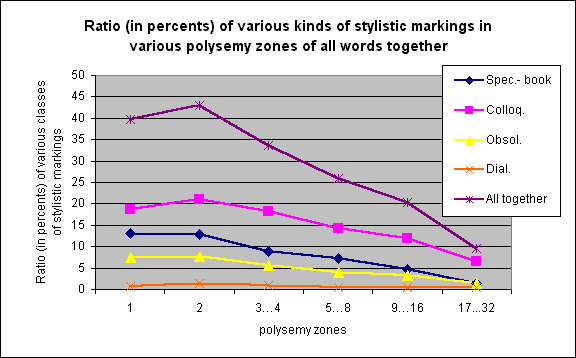
Figure 1a. Ratio of various kinds of stylistic marking of nouns' meanings in various polysemy zones
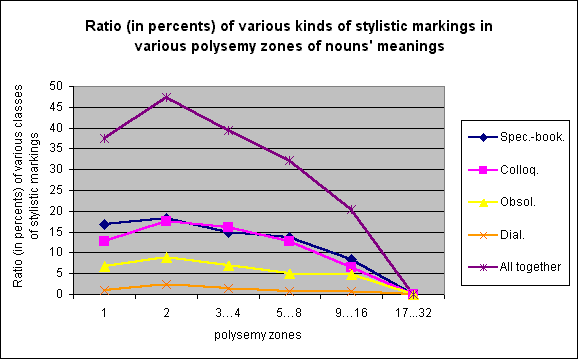
Figure 1b. Ratio of various stylistic marking of verbs
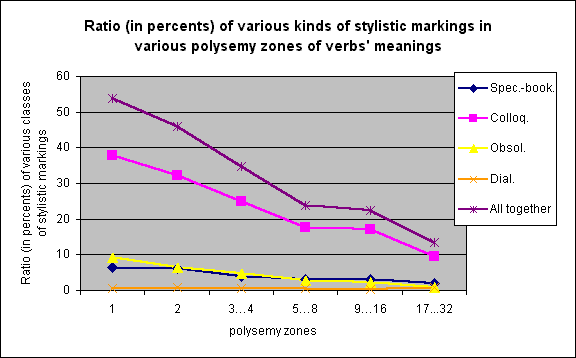
Figure 1c. Ratio of various stylistic marking of adjectives
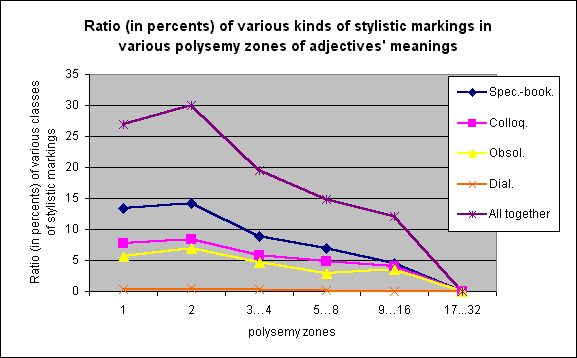
Figure 1d. Ratio of various kinds of stylistic marking of adverbs' meanings
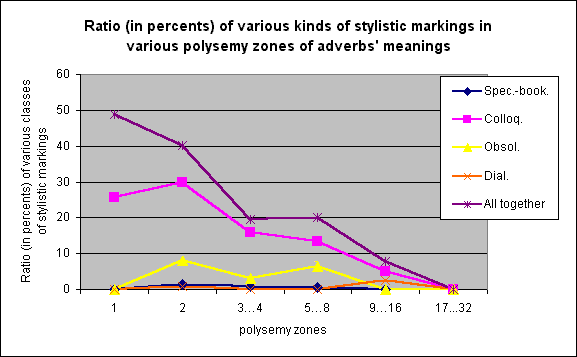
Figure 1e. Ratio of various kinds of stylistic marking of all the remaining parts of speech
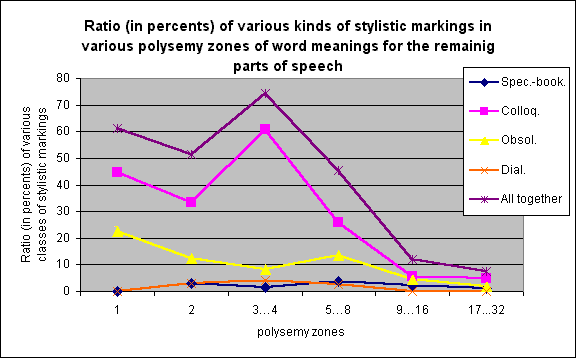
At the same time, the following three most significant facts defying the general trend have to be pointed out. Firstly, what most conspicuously contradicts the above trend is the transition from the zone of words having two meanings to the zone of monosemantic words in terms of meanings marked as colloquial. The markedness degree of monosemantic words turns out to be much lower than could be expected judging from the data on other polysemic zones. First of all, this can be attributed to the nature of colloquial markings acquired mainly by the words that have existed in the language for some time and therefore managed to acquire the second, the third, etc. meanings in addition to the original one with which they entered into the language, i.e., these are clearly non-monosemantic words. However, it can also be supposed that the observed phenomenon is accounted for by incomplete representation of monosemantic vocabulary and, specifically, highly colloquial stock in DRL. If so, a more complete, more objective recording of colloquial resources of Russian vocabulary (as it seems, of the most specific, rare, monosemantic units) could restore the systemic relation between the number of colloquial meanings of monosemantic and non-monosemantic words. The second cause seems to us more significant than the first one.
Secondly, another salient incongruity consists in the fact that the general trend towards increasing number of LSVs having markings of the bookish-specialized class when proceeding from the most polysemic words to ever smaller polysemies is also noticeably disturbed at the transition point from words having two meanings to monosemantic words which fact is manifested in lack of change in this parameter. The "frozen" trend may also be attributed to the shortage, incomplete representation in DRL of peripheral, specialized, branch vocabulary that is more likely to be monosemantic compared to other lexical classes.
Thirdly, the share of LSVs having bookish-specialized markings for all parts of speech turns out to be considerably lower compared to LSVs having colloquial markings (11.48% and 18.53%, respectively). This is clearly seen in Figure 1. Such proportion contradicts an intuitive perception of the colloquial lexical stock as nuclear and rather small in size and of the bookish-specialized vocabulary as the periphery of the lexical stock of a developed literary language that is very extensive, much larger than the nucleus.
8. The suppositions of the incomplete representation in DRL of vocabulary that is peripheral yet really existing in language are corroborated by the lexicographical conception of the dictionary as the compilers themselves formulate it. Indeed, when solving the question of including or not including certain classes of vocabulary into DRL the authors fail to set major restrictions only for one of the four groups that are of interest to us in stylistic terms: the group of colloquial means. According to DRL compilers, the only restriction was non-inclusion of "most rude vulgar words"
[YEVGENYEVA, 1957-1961, Vol. 1, p.VII] whose fewness in comparison with the total size of the colloquial stratum is beyond any doubt. At the same time, the compilers failed to list "highly specialized terms from specific fields of science, engineering, arts that are necessary only for specialists"
[YEVGENYEVA, 1957-1961, p.VII], i.e. the access for actual specialized vocabulary to DRL was strongly limited. Also excluded from DRL were some classes of derived nouns, adjectives and adverbs (that are "easily formed and understood")
[YEVGENYEVA, 1957-1961, p.VII] which are clearly more likely, than their underlying words, to be peripheral, specialized (and therefore oligosemantic) units.
Selective examination of various alphabetical sections of DRL reveals the absence of many specialized words and meanings typical of modern Russian usage in professional fields (e.g., listed in specialized dictionaries).
9. Deeper analysis of stylistic marking structure of the dictionary of the literary language can be implemented if we consider specific characters of different lexicalgrammatical classes (parts of speech) in terms of various classes of stylistical markings.
In the analysis, groups of LSVs of words belonging to basic parts of speech: noun, verb, adjective, adverb and the group of remaining parts of speech are considered separately.
First of all, among all classes of words the group of remaining parts of speech displays the greatest markedness degree: their meanings having stylistical markings constitute 50.90% of the total number of all marked and unmarked meanings of words of that category. This fact may cause surprise since, at first sight, it would be natural to surmise that syntactic and common words which in most cases fulfil syntactic rather than nominative functions are supposed to serve all types of speech activity in any field of communication and, therefore, should be neutral in any context, unmarked. However, the misunderstanding is sorted out when we take a look at the list of words to find out that many of them are specialized lexical units typical of colloquial speech only (interjections, particles, etc.), i.e. they constitute a special group featuring pronounced functional orientation and colour.
Among four basic autosemantic parts of speech (see Table 1
and figures 2-6), meanings of verbs have the greatest markedness degree: 42.29% of the total number of meanings of verbs. The number of stylistically marked LSVs of monosemantic verbs is 6059 out of 11247, or 53.87% ; the number of stylistically marked LSVs of polysemantic verbs is 7035 out of 19714, or 35.69%. As can be seen from the data, gravitation of markedness towards meanings of monosemantic words is beyond any doubt.
Figure 2. Dependence of "Specific-bookish" marking of word meanings of different parts of speech words from different polysemy zones which words belong to
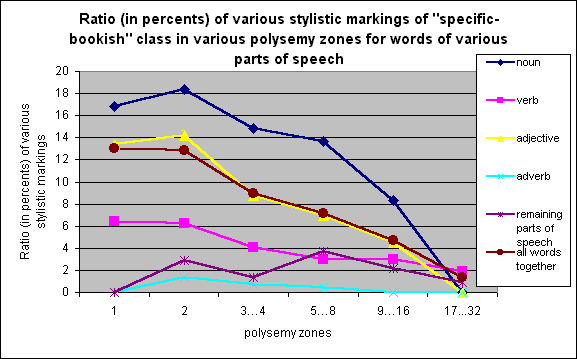
Figure 3. Dependence of "Colloquial" marking of word meanings of different parts of speech words from different polysemy zones which words belong to
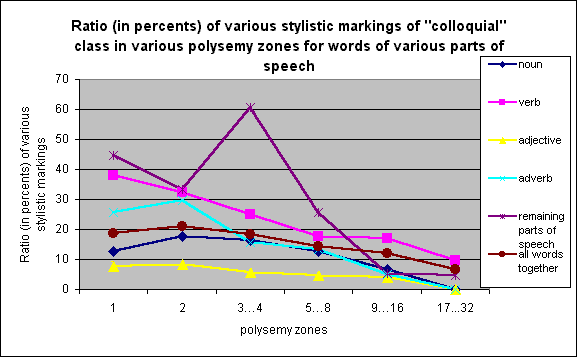
Figure 4. Dependence of "Obsolete" marking of word meanings of different parts of speech words from different polysemy zones which words belong to
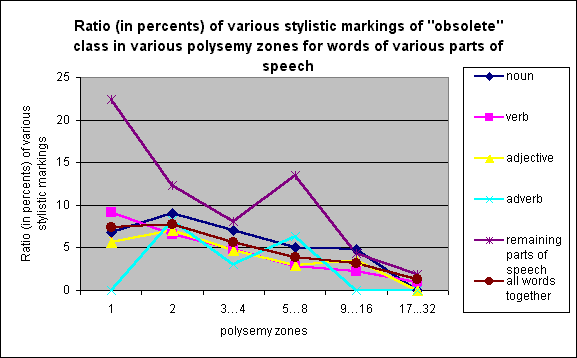
Figure 5. Dependence of "Dialectal" marking of word meanings of different parts of speech words from different polysemy zones which words belong to
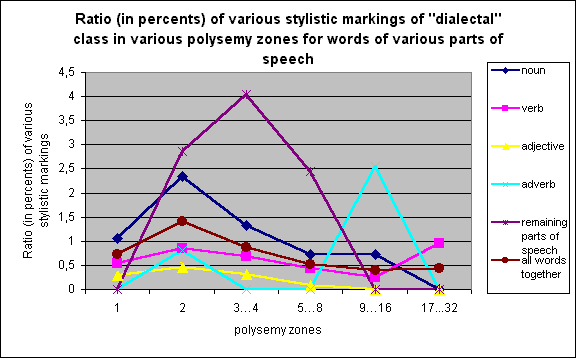
Figure 6. Dependence of any kind of stylistic marking of word meanings of different parts of speech words from different polysemy zones which words belong to
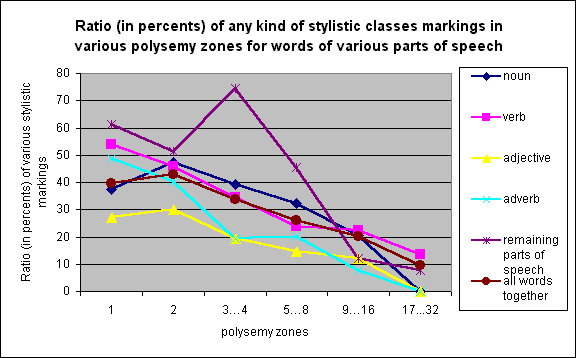
The total markedness degree of meanings of nouns is lower but not too much: 39.22% of the total number of all meanings of nouns (or 16426 out of 41883). Respective data for LSVs of monosemantic nouns: 37.45%, or 3457 out of 22582, for LSVs of polysemantic nouns: 41.29%, or 7969 out of 19301.
Next in stylistical markedness sequence come adverbs and adjectives (see Table
1).
It has to be admitted that greater markedness degree with all types of markings was expected a priori for nouns rather than verbs or any other part of speech. This question requires special examination but, undoubtedly, nouns would have been much more marked with markings of all classes (first of all with bookish-specialized markings - see below) if this category of Russian words had been represented in DRL more fully, than was admissible according to the compilers' conception, both in terms of whole specialized words and separate specialized meanings.
10. Even more interesting is detailed examination of dynamics of general stylistical markedness of LSVs for each part of speech when proceeding from the zone of monosemantic words to the zones of words having 2, 3, 4, etc. meanings (see Table
1 and Figures 2). The analysis reveals that when moving in this direction the general trend of decreasing LSV stylistical markedness degree is observed for all parts of speech without exception. Putting aside "remaining parts of speech" for the time being, let us state that this trend is distorted most noticeably only for nouns and verbs in the transition point from monosemantic words to words having two meanings which fact requires explanation. In all likelihood, the general shortage of monosemantic, specific vocabulary in DRL (which is reflected, specifically, in the character of stylistical markedness) is due mainly to the shortage of monosemantic words belonging to these two parts of speech.
11. It can be seen from the Table 1 and Figures 1-6 that the greatest contribution to total bookish-specialized markedness of DRL is made by meanings of nouns and adjectives. If we subscribe to the assertion that DRL rather inadequately reflects specialized LSVs of nouns and adjectives that are peripheral but really existing in the language then a more complete representation of these categories of lexical units in such a dictionary could produce a significant increase in their contribution to the total markedness of the lexical stock of the dictionary, systemic trends related to markedness degree distribution of LSVs of words in various polysemic zones manifesting themselves in a more explicit, more clear way. Specifically, after including into DRL of many adjective terms, adverbs
ended by affixes -o, -e regularly
derived from the adjectives percentage of specifically marked meaning could also emerge. This could presumably result in altered proportion of LSV markedness with two polar classes of markings: colloquial and bookish-specialized. Colloquial markings dominate in the present edition of DRL. Calculations of various types indicate that the shortage of bookish- specialized lexical units in DRL amount to several tens of thousands. If so, then the most spacious stylistical class in the dictionary (as well as in the whole language) would predictably be the bookish-specialized one, represented, as it seems, mainly by LSVs of nouns and adjectives.
12. Thus, an attempt has been made in the present paper to generalize diverse stylistical markings into four basic classes and differentially investigate the stylistical markedness of LSVs of various grammatical categories (parts of speech) in different polysemic zones of DRL. The research allowed to reveal important systemic tendencies in dictionary organization inherent in language vocabulary as a whole as well as some deviations from the tendencies accountable for by certain lexicographic factors.
One area of advanced experimental research of this sort involves obtaining similar data for short and large dictionaries of the Russian language, their comparative analysis and interpretation of the results in terms of relation of strata (spheres) of vocabulary conscience of society.
Notes
1. See, e.g., [BORODA, POLIKARPOV, 1984; SHMELYOVA T.V. (Ed.), 1987; TULDAVA. 1987; POLIKARPOV, 1988; KARIMOVA, POLIKARPOV,
1989].
2. At present, research is also underway on the second edition of the above dictionary
[YEVGENYEVA, 1981-1984]. Presentation of the analysis and its comparison, in terms of some parameters, with the results obtained on the first edition provide a subject for a separate publication.
3. See, e.g., [SHMELYOVA, 1975; SHMELYOV, 1977; SKLYAREVSKAYA, 1974; 1988a; BALAKHONOVA, 1983; PETRISHCHEVA, 1984]. Cf also [FILIN, 1966; SHMELYOVA, 1966; 1969; DENISOV, KOSTOMAROV, 1970; SKLYAREVSKAYA, 1973a; 1973b; 1974; FILIN. 1973; SHMELYOV, 1973; BURTSEVA, 1975; GAK, 1977; BONDALETOV, 1982; BABKIN. 1983; BERKOVICH, 1988; MURAT, 1988; SKVORTSOV,
1988].
4. Preliminary attempts in this field have been made in [POLIKARPOV, 1987; POLIKARPOV, KRYUKOVA,
1989].
5. Substantiation of the method and analysis of other aspects of such vocabulary classification see in
[POLIKARPOV, 1987].
6. Here and henceforth, in presenting analysis results, the term "dictionary" refers to the investigated part of DRL (1st, 2nd and 4th volumes).
7. The upper limit of the last zone was raised to 34 meanings because it would not make sense to set up a separate zone (33-64) for a single word having 34 meanings (preposition 'ў').
REFERENCES
BABKIN A.M. [1983]. Ustarelyye Slova v Sovremennom Yazyke i Slovare (Obsolete Words in the Modern Language and Dictionary) // Sovremennaya russkaya leksikografiya. 1981. - L.: Nauka Publishers, 1983. - P.4-33.
BALAKHONOVA L.I. [1983]. Leksika Dialektnogo Proiskhozhdeniya v Sovremennom Russkom Literaturnom Yazyke kak Obyekt Leksikografii i Leksikologii (Vocabulary of Dialectal Origin in the Modern Russian Literary Language as an Object of Lexicology and Lexicography). // Sovremennaya russkaya leksikografiya. 1981. - L.: Nauka Publishers, 1983. - P.150-155.
BERKOVICH T.L. [1988]. Soderzhaniye i Funktsii Pomet dlya Terminologicheskoy Leksiki v Obshchikh Slovaryakh Raznykh Tipov (Content and Functions of Markings for Terminological Vocabulary in Various Types of General Dictionaries) // Slovarnyye kategorii. - M.: Nauka Publishers, 1988. - P.206-210.
BONDALETOV V.D. [1982]. Stilisticheskiye Resursy Leksiki Russkogo Yazyka (Stylistical Resources of the Russian Vocabulary) // Leksika i slovoobrazovaniye russkogo yazyka. - Ryazan, 1982. - P.6-28.
BORODA M.G., POLIKARPOV A.A. [1984]. Zakon Tsipfa-Mandelbrota i Yedinitsy Razlichnykh Urovney Organizatsii Teksta (Zipf-Mandelbrot's Law and Units of Various Levels of Text Organization) // Quantitative Linguistics and Automatic Text Analysis (Acta et Commentationes Universitatis Tartuensis. - Vol.689). - Tartu: Tartu University Press, 1984. - P.35-60.
BURTSEVA V.V. [1975]. Slovo s Pometoy "Spetsialnoye" v Semnadtsatitomnom Akademicheskom "Slovare Sovremennogo Russkogo Literaturnogo Yazyka" (1948-1965) (Word with the Marking 'Specialized' in the 17-Volume Academic "Dictionary of the Modern Russian Literary Language" (1948-1965)): Avtoref. diss. ... kand. filol. nauk. - M., 1975. - 24p.
DENISOV P.N., KOSTOMAROV V.G. [1970]. Stilisticheskaya Differentsiatsiya Leksiki i Problema Razgovornoy Rechi (Stylistical Differentiation of Vocabulary and the Problem of Colloquial Speech) // Russkaya razgovornaya rech. - Saratov, 1970. - P.69-75.
FILIN F.P. [1966]. K Probleme Sotsialnoy Obuslovlennosti Yazyka (On the Problem of Social Conditioning of language) // Voprosy Yazykoznaniya, 1966, No 4, pp.31-44.
FILIN F.P. [1973]. O Strukture Sovremennogo Russkogo Literaturnogo Yazyka (On the Structure of the Modern Russian Literary Language) // Voprosy yazykoznaniya, 1973, No 2, pp.5-12.
FILIN F.P. et al. (Eds.) [1948-1965]. Slovar Sovremennogo Russkogo Literaturnogo Yazyka: V 17-i Tomach (Dictionary of the Modern Russian Literary Language: In 17 Volumes) / USSR Academy of Sciences, Institute of linguistics. - M.-L.: Publishing House of the USSR Academy of Sciences, 1948-1965.
GAK V.G. [1977]. Sopostavitelnaya Leksikologiya. (Na Materiale Frantsuzskogo i Russkogo Yazykov) (Contrastive Lexicology. (On the Basis of French and Russian Data)) - M.: Mezhdunar. Otnosheniya, 1977. - 264 p.
KARIMOVA G.O., POLIKARPOV A.A. [1989]. Printsipy Vydeleniya Giperleksemy kak Yedinitsy Leksicheskoy Sistemy Yazyka (Principles for Singling out Hyperlexeme as a Unit of the Lexical System of language) // Derivatsionnyye tipy i gnyozda v sinkhronii i diakhronii. - Vladivostok: DVO AN SSSR, 1989. - P.158-168.
MURAT V.P. [1988]. Stilisticheskaya Sistema Sovremennogo Russkogo Yazyka po Dannym "Slovarya Russkogo Yazyka" S.I.Ozhegova (Stylistical System of the Modern Russian Language as seen on the Basis of Data of S.I.Ozhegov's "Dictionary of the Russian Language) (14th edition, 1982) // Slovarnyye kategorii. - M.: Nauka Publishers, 1988. - P.134139.
OZHEGOV S.I. [1949]. Slovar Russkogo Yazyka (Dictionary of the Russian Language) / Ed. by Acad. S.P.Obnorskiy. - M., 1949; - 9th edition, corrected and updated / Ed. by Prof. N.Yu.Shvedova. - M., 1972; - 21st edition, revised and updated / Ed. by Corresponding Member of the USSR Academy of Sciences N.Yu.Shvedova. - M.: Russian Language Publishers, 1989.
OZHEGOV S.I. [1952]. O Tryokh Tipakh Tolkovykh Slovarey Sovremennogo Russkogo Yazyka (On Three Types of Explanatory Dictionaries of the Modern Russian Language) // Voprosy yazykoznaniya, 1952, No 2, pp. 85-103.
PANOV M.V. (Ed.) [1968]. Russkiy Yazyk i Sovyetskoye Obshchestvo. (The Russian Language and the Soviet Society) - Kn. 1. Leksika Sovremennogo Russkogo Literaturnogo Yazyka (Issue 1. Vocabulary of the Modern Russian Literary Language). - M.: Nauka Publishers, 1968. - 187p.
PETRISHCHEVA Ye.F. [1984]. Stilisticheski Okrashennaya Leksika Russkogo Yazyka (Stylistically Coloured Vocabulary of the Russian Language). - M.: Nauka Publishers, 1984. - 222p.
POLIKARPOV A.A. [1987]. Polisemiya: Sistemno-Kvantitativnyye Aspekty (Polysemy: Systemic-Quantitative Aspects) // Quantitative linguistics and automatic text analysis (Acta et Commentationes Universitatis Tartuensis. - Issue 774). - Tartu: Tartu University Press, 1987. - P.135-154.
POLIKARPOV A.A. [1988]. Logicheskoye Prostranstvo Yedinits Leksicheskoy Podsistemy Yazyka i Kvantifikatsiya Sootnosheniy mezhdu nimi (Logical Space of Units of the Lexical Subsystem of Language and Quantification of Relations between them) // Prikladnaya lingvistika i avtomaticheskiy analiz teksta: Papers from the Scientific Conference, Jan. 28-30, 1988. - Tartu, 1988. - P.67-69.
Polikarpov A.A. A model of the word life cycle / Ed. by Koehler, R., Rieger, B.
// Contributions to quantitative linguistics. Dordrecht; London; Boston, 1993.
Polikarpov
A.A
Cognitive Model of Lexical System Evolution and its Verification // Human
Language (HumLang) electronic bulletin (list) www.philol.msu.ru/~humlang/
-
POLIKARPOV A.A., KRYUKOVA O.S. [1989]. O Sistemnom Sootnoshenii Kratkogo i Srednego Tolkovykh Slovarey Russkogo Yazyka (On Systemic Relation between Small and Medium-Size Dictionaries of the Russian Language) // Quantitative linguistics and automatic text analysis (Acta et Commentationes Universitatis Tartuensis. - Issue 872). - Tartu, 1989. P.111-125.
POLIKARPOVA A.O., POLIKARPOV A.A. [1987]. Opyt Izucheniya Urovnya i Kharaktera Individualnogo Znaniya Russkoy Leksiki (Essay of Investigation of the Level and Character of Individual Command of Russian Vocabulary) // Kvantitativnyye aspekty sistemnoy organizatsii teksta: Materialy Mezhvuz. seminara. - Tbilisi, 1987. - P.92-96.
SHMELYOV D.N. [1973]. Problemy Semanticheskogo Analiza Leksiki (Problems of Semantic Analysis of Vocabulary). - M.: Nauka Publishers, 1973. - 280p.
SHMELYOV D.N. [1977]. Russkiy Yazyk v Yego Funktsionalnykh Raznovidnostyakh (The Russian Language in its Functional Varieties). - M.: Nauka Publishers, 1977. - P.101-111.
SHMELYOVA I.N. [1966]. Stilisticheskiye Sdvigi v Leksike Sovremennogo Russkogo Literaturnogo Yazyka (po Materialam Pismennykh Istochnikov i Tolkovykh Slovarey) (Stylistical Shifts in the Vocabulary of the Modern Russian Literary Language (on the Basis of Data of Written Sources and Explanatory Dictionaries)) // Normy sovremennogo russkogo literaturnogo slovoupotrebleniya. - M. - L.: Nauka Publishers, 1966. - P.24-42.
SHMELYOVA I.N. [1969]. "Narodno-Krestyanskaya" Leksika v Sovremennom Russkom Literaturnom Yazyke ("Folk-Peasant" Vocabulary in the Modern Russian Literary Language) // Voprosy teorii i istorii yazyka. - L.: Leningrad University Press, 1969. - P.236-241.
SHMELYOVA I.N. [1975]. Nekotoryye Voprosy Stilistiki v Obshchem Slovarye Literaturnogo Yazyka (Some Problems of Stylistics in General Dictionary of Literary Language) // Sovremennaya russkaya leksikografiya. - L.: Nauka Publishers, 1975. - P.24-39.
SHMELYOVA T.V. (Ed.) [1987]. Sistemnyy Analiz Znachimykh Yedinits Russkogo Yazyka. Paradigmatika v Leksike i Slovoobrazovanii (Systemic Analysis of Meaningful Units of the Russian Language. Paradigmatics in Vocabulary and Word Formation). - Krasnoyarsk, 1987. - 144p.
SKLYAREVSKAYA G.N. [1973a]. O Sootnoshenii Leksikograficheskikh Ponyatiy "Razgovornoye" i "Prostorechnoye" (On the Relation between Lexicographical Notions 'Colloquial' and 'Vulgar'): Avtoref. diss. ... kand. filol. nauk. - L., 1973. - 19p.
SKLYAREVSKAYA G.N. [1973b]. Razgovornaya Rech kak Obyekt Lingvisticheskogo Issledovaniya (Colloquial Speech as an Object of Linguistic Research) // Lingvisticheskiye issledovaniya. 1972. Part 1 / USSR Academy of Sciences; Institute of linguistics. - M., 1973. - P.3-22.
SKLYAREVSKAYA G.N. [1974]. Poludialektnaya Leksika v Sovremennom Russkom Yazyke (Semi-Dialectal Vocabulary in the Modern Russian Language) // Voprosy stilistiki. - Vyp. 7.- Saratov: Saratov University Press, 1974. P. 48-59.
SKLYAREVSKAYA G.N. [1974]. Zametki O Leksikograficeskoy Stilistike (Notes on Lexicographical Stylistics) // Sovremennost i slovari. - L.:Nauka Publishers, 1978. - P.101-111.
SKLYAREVSKAYA G.N. [1988a]. Leksikograficheskaya Stilistika: Sostoyaniye i Problemy (Lexicographic Stylistics: State of the Art and Problems) // Slovarnyye kategorii. - M.: Nauka Publishers, 1988. - P.150-155.
SKLYAREVSKAYA G.N. [1988b]. Yeshcho Raz o Leksikograficheskoy Stilistike (Once Again about Lexicographical Stylistics) // Voprosy Yazykoznaniya, 1988, No 3. - P.84-97.
SKVORTSOV L.I. [1988]. Normativno-Stilisticheskiy Slovar v Sisteme Normativnoy Leksikografii (Normative-Stylistical Dictionary in the System of Normative Lexicography) // Natsionalnaya spetsifika yazyka i yego otrazheniye v tolkovom slovare: Collection of papers / Institute of the Russian language. - M.: Nauka Publishers, 1988. - P.39-43.
TULDAVA J.A. [1987]. Problemy i Metody Kvantitativno-Sistemnogo Issledovaniya Leksiki (Problems and Methods of Quantitative-Systemic Investigation of Vocabulary). - Tallinn: Valgus, 1987. - 204p.
USHAKOV D.N. (Ed.) [1935-1940]. Tolkovyy Slovar Russkogo Yazyka: V 4-kh Tomach (Explanatory Dictionary of the Russian Language: In 4 Volumes). - M.: OGIZ, 1935-1940.
YEVGENYEVA A.P. (Ed.) [1957-1961]. Slovar Russkogo Yazyka: V 4-kh Tomakh (4-Volume Dictionary of the Russian language) // USSR Academy of Sciences, Institute of the Russian language: M., 1957-1961.
YEVGENYEVA A.P. (Ed.) [1981-1984]. Slovar Russkogo Yazyka: V 4-kh Tomakh (4-Volume Dictionary of the Russian Language) // USSR Academy of Sciences, Institute of the Russian language. 2nd edition, revised and updated. - M.: Russian Language Publishers, 1981-1984.